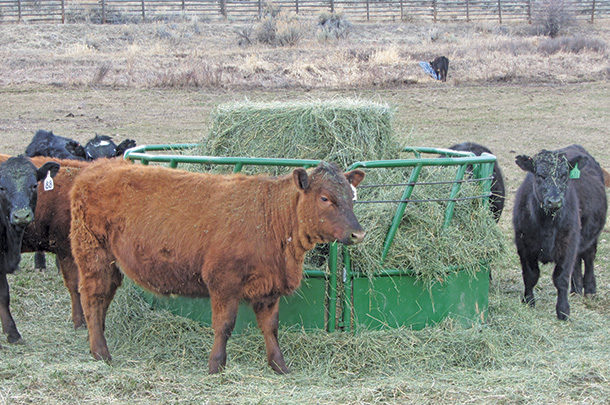Successfully developing good replacement heifers depends on many factors, including age at puberty, herd health (biosecurity, vaccination, etc.) and nutrition. Fertility/age at puberty are somewhat heritable, but influenced by nutrition.
Heifers need optimal nutrition for growth and development, but this doesn’t mean overfeeding. A heifer genetically programmed for early puberty and fertility, on a moderate plane of nutrition, will usually be more successful for a long life of production than a less-fertile heifer that is overfed to reach her “target weight” for breeding. Heifers can be developed with minimal cost and still become good replacements.
Dr. Rick Funston, extension beef reproductive physiologist, University of Nebraska, says it all starts with selection, making sure heifers have good functionality traits. Dr. Jim Gosey, beef specialist and professor emeritus, University of Nebraska, says the first sort starts at weaning – removing any heifers born late or from cows that needed assistance at calving or dams with big teats, etc. He also suggests removing heifers that are exceptionally small at weaning or have poor dispositions.
Gosey says that after undesirable heifers are removed, consider developing the rest and exposing them to a bull for a short breeding season (30 to 45 days) to select for those that are most fertile. If you can only keep a small number to develop, keep daughters from older cows that have worked well in your production environment.
When developing heifers, Funston suggests utilizing feed resources they will be expected to consume as mature cows. Research has shown that heifers can be developed to 50%-57% of their mature weight at breeding (rather than the traditional 65% of projected mature weight) and not impair reproductive performance. For this to work, however, it’s critical that an appropriate level of nutrition is available prior to breeding and through calving.
Age of heifers at breeding makes a difference. “We did a research retroanalysis looking at when heifers were born – early born versus late in the calving season. When trying to avoid selecting for the biggest heifers, which tends to move frame size larger in the cow herd, we make sure we don’t cull earlier-born heifers just because they are bigger. We want early born heifers out of moderate-frame cows. It’s been proven that these older heifers reach puberty sooner, breed earlier, calve earlier and stay in the herd longer,” says Funston.
“If a person has the luxury to expose more heifers than needed, only keeping the ones that breed early, the heifers conceiving in their first cycle at the start of the breeding season, are more fertile; on average, they essentially wean two more calves by the time they have their sixth calf. Their longevity in the herd is greater, as well,” he says.
Jordan Thomas, a state beef reproduction specialist, University of Missouri Division of Animal Sciences, says that if only a small number of heifers are developed, you end up having to retain all the ones that become pregnant, even if some conceived late. Many people breed heifers for 60 days, but there’s a lot of difference between a heifer that conceived on the first day and one that conceived on the last day. “On many operations, the resulting calving season is too long,” says Thomas.
Within a heifer development program, he says there are actually three products: the bred heifer that is retained, the bred heifer to market (that will calve later) and the open heifer.
“Deciding whether to use a short or long breeding season is just a business decision. If cost of heifer development is high and open heifers are unprofitable from a value-of-gain perspective, it’s better to use a longer breeding period and market the later-bred heifers. If later-bred heifers are challenging or unprofitable to market, use a shorter breeding period. Either way, the operation needs to develop enough heifers to be selective about which ones stay,” he explains.
“Sometimes, such as in drought, it makes sense to sell some cows and keep more heifers. It takes less feed to winter a heifer than a pregnant cow. Some folks pitch this as keeping the newest, best genetics – a heifer instead of the older cow – but those heifers have not yet proven themselves. From a feed/demand perspective, however, the heifers take a lot less to get them through winter,” says Thomas.
Advantages of lower-input systems
Funston recommends running heifers in a yearling system. They don’t have to gain more than 1.5 pounds per day; many will be successful if they gain between 1 and 1.5 pounds. Those that are open can be sold as feeder animals. He likes a long breeding season and short calving season. Have your veterinarian check heifers and tell you which ones conceived early. The others can be marketed as later calvers, or open.
“Our lower-input systems – developing heifers more slowly, on forage-based rations or on pasture – actually result in higher pregnancy rates. One explanation is that having heifers on a higher rate of gain than they’ll be able to achieve after you breed them can be detrimental to embryonic development – with more embryonic loss. Our range-raised and cornstalk-grazed heifers, after we breed them and until we ultrasound them for pregnancy diagnosis, gain as much as a pound a day more than the animals that were either on a higher plane of nutrition or confined during development,” he says.
There are two things that the researchers tried to sort out. “We simulated the range/cornstalk system in a drylot situation, and those heifers gained as much as the ones running out, but the heifers that were locked up didn’t have the compensatory gain when they went out after A.I. breeding. There is a learned behavior that we are compromising by confining heifers in a system that they will never see again.”









